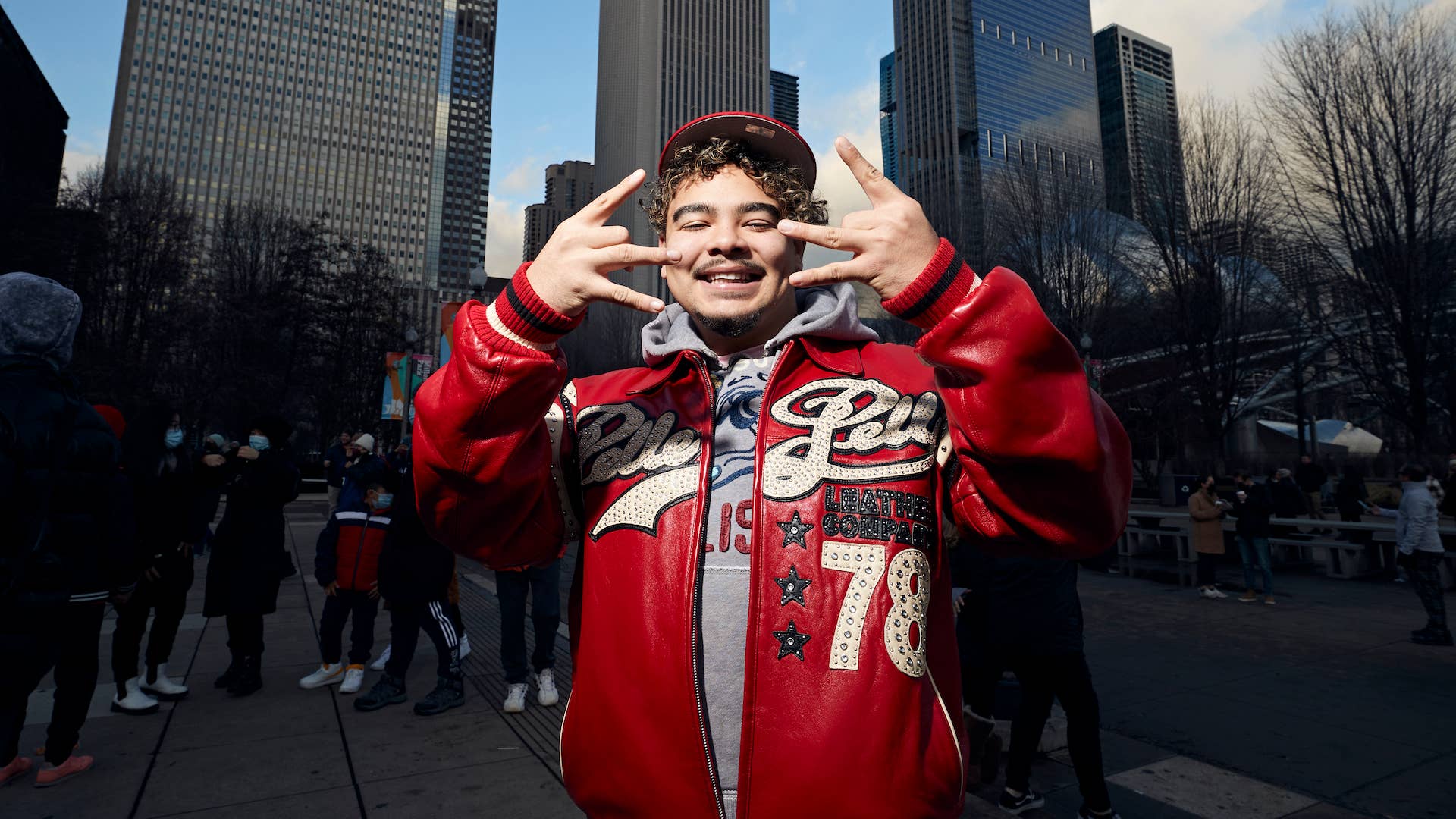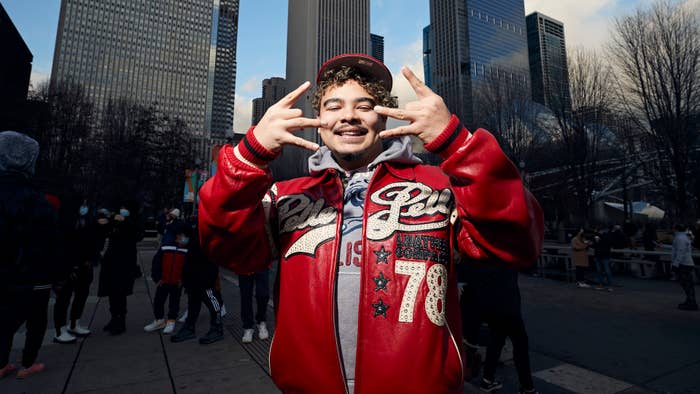
This fall in Chicago and New York, groups of leather jacket enthusiasts came together to celebrate “Pelle Pelle Day.” East Harlem native Miguel Rodriguez organized the events. He’s a collector who runs an Instagram account with just over 2,500 followers called @PellePelleLeather—an archive page dedicated to documenting the history of the American leather jacket label Pelle Pelle by Marc Buchanan. At New York City’s Pelle Pelle Day in Times Square, nearly 20 collectors came from across all five boroughs to show off their rarest Pelle Pelles. One 24-year-old attendee from uptown Manhattan arrived in an all-black leather studded “Soda Club” jacket he inherited from his father. Another collector from Canarsie, Brooklyn proudly turned around to show off an intricate embroidery of three men playing Cee-lo on his back. And many of the younger enthusiasts in their 20s were awed by a 40-year-old man from South Jamaica, Queens who had on one of the oldest jackets in sight, an orange Pelle Pelle with a baseball graphic on the back that he purchased for $700 in 1998. As New York drill blasted from a set of Bluetooth speakers, collectors who never met dapped each other up, gushed over the Pelle Pelles surrounding them, and posed for pictures before coming together for a family photo.
“I think people feel like Marc Buchanan was like their uncle. When you bought a coat from Marc Buchanan it was like a co-sign. I still haven’t figured out why people go so hard for him when nobody’s even met him,” says Rodriguez, who is better known as Mikey Phelps. “I don’t even see pictures of him on the internet. He’s this mysterious presence who just makes you feel comfortable, fly, and nostalgic. He embraced the culture and the culture embraced him.”
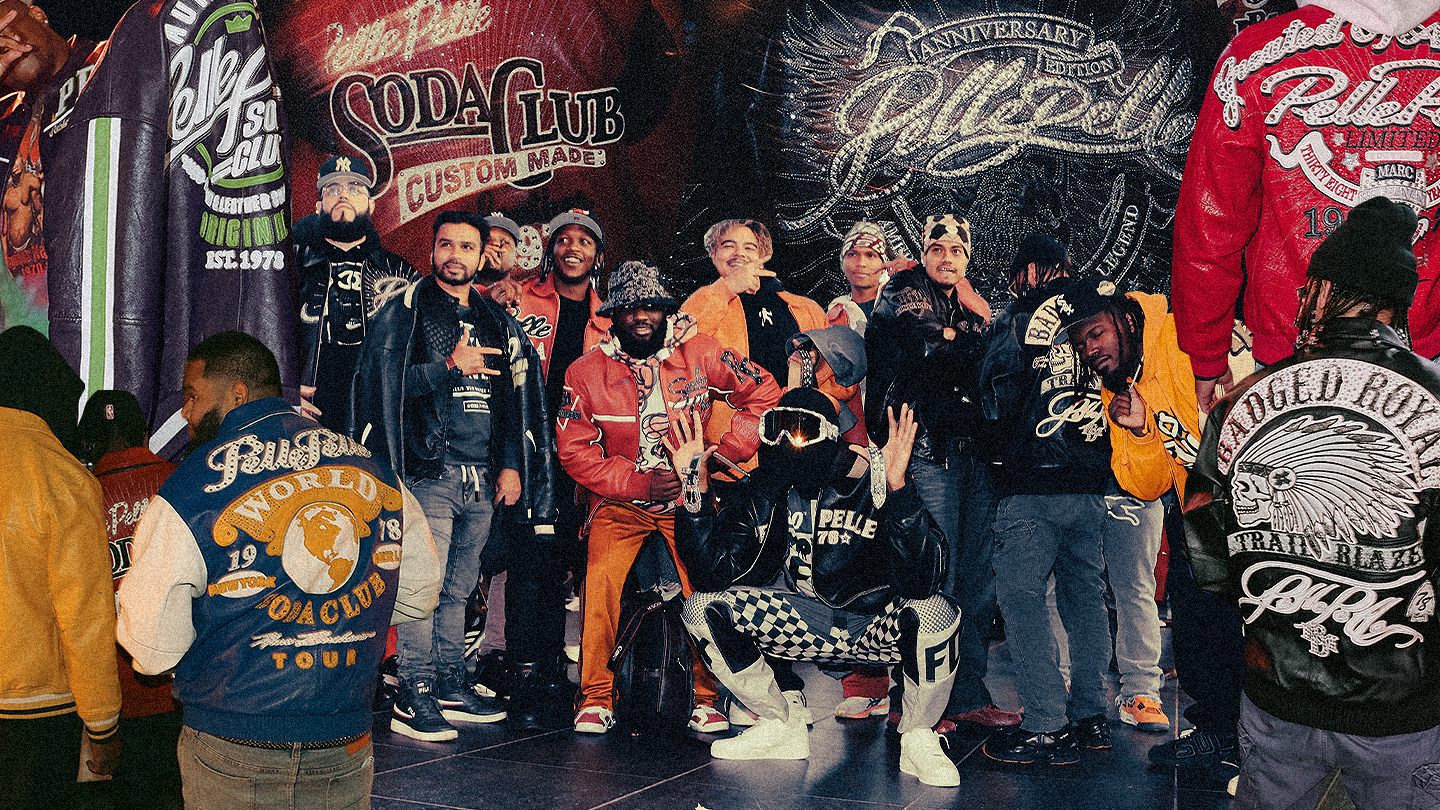
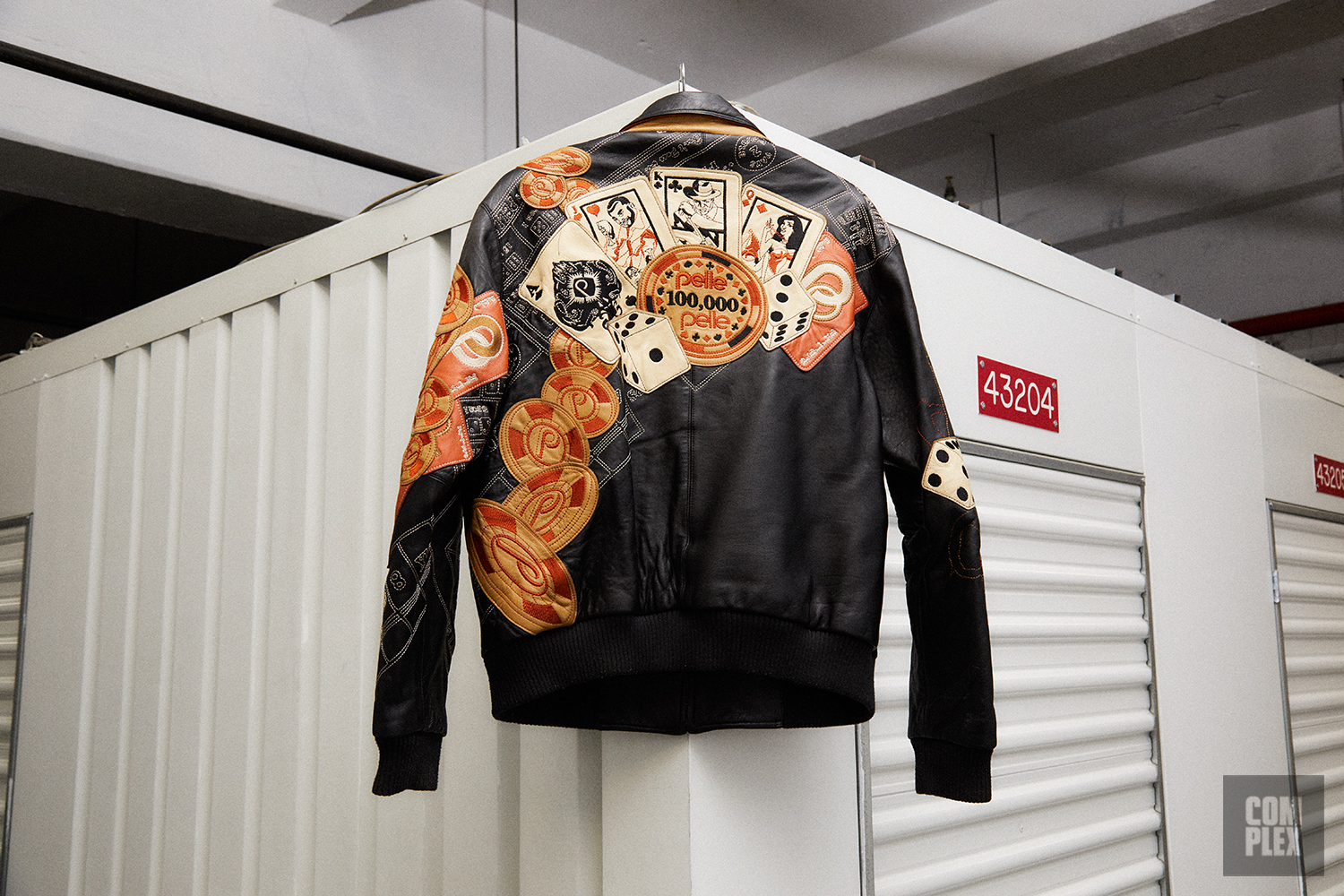
Buchanan studied art since he was a child. He painted, made sculptures, and crafted his first garments before graduating high school. He learned how to design leather jackets by looking through old pattern books from the 1940s that his business partner acquired. When Buchanan realized that he had a better chance of becoming a successful leather jacket designer rather than an artist, he decided to quit school and sold off his stake in Gandalf to pursue freelance leather design work. Buchanan launched Pelle Pelle in 1978, which is Italian for “Leather Leather,” because he noticed a gap in the leather jacket market that he could fill. Pelle Pelle was going to make a luxurious, but affordable, high fashion leather jacket.
“It was just like doing a painting. I can sketch a jacket in probably less than 30 seconds.”—Marc Buchanan
By 1983, Buchanan was selling his colorful Pelle Pelle jackets at trade shows like Magic. Instead of large department stores, he distributed Pelle Pelle to small specialty shops like City Blue in Philadelphia and Blue Jeans in New York because they targeted the urban audience he wanted to reach and were easier to work with. Buchanan strongly believed that department stores didn’t help brands grow but treated them more like “revenue centers” and disdainfully recalled how one Detroit department store even attempted to make him foot the bill when Pelle Pelles were stolen from its stockroom. He ignored chasing leather jacket trends—he avoided producing jackets inspired by Michael Jackson’s “Thriller” video—so he could give Pelle Pelle its own unique brand identity. To do that, Buchanan applied concepts he learned from art school to his designs. Buchanan, who compares his jackets to stained glass windows, drew nearly all of his designs by hand. He says he came up with so many different styles for Pelle Pelle by keeping an open mind. One iconic Pelle Pelle motif that Bucahnan began developing in the ‘80s was a quilted leather jacket he decorated with graphic appliqués that formed collages inspired by cities where he had a big following like New York and Chicago. By 1991, everyone from Will Smith in The Fresh Prince of Bel-Air and the late night television host Arsenio Hall wore Pelle Pelle jackets.
“The hip-hop community came in, looked at what I was doing, and said: ‘Hey, we like this and we’re going to support this,’ says Buchanan. “That was great for me because I could get really creative. I don’t have to dumb stuff down because I have this community that likes this creative stuff. It was a perfect match and I could not have asked for a better customer.”
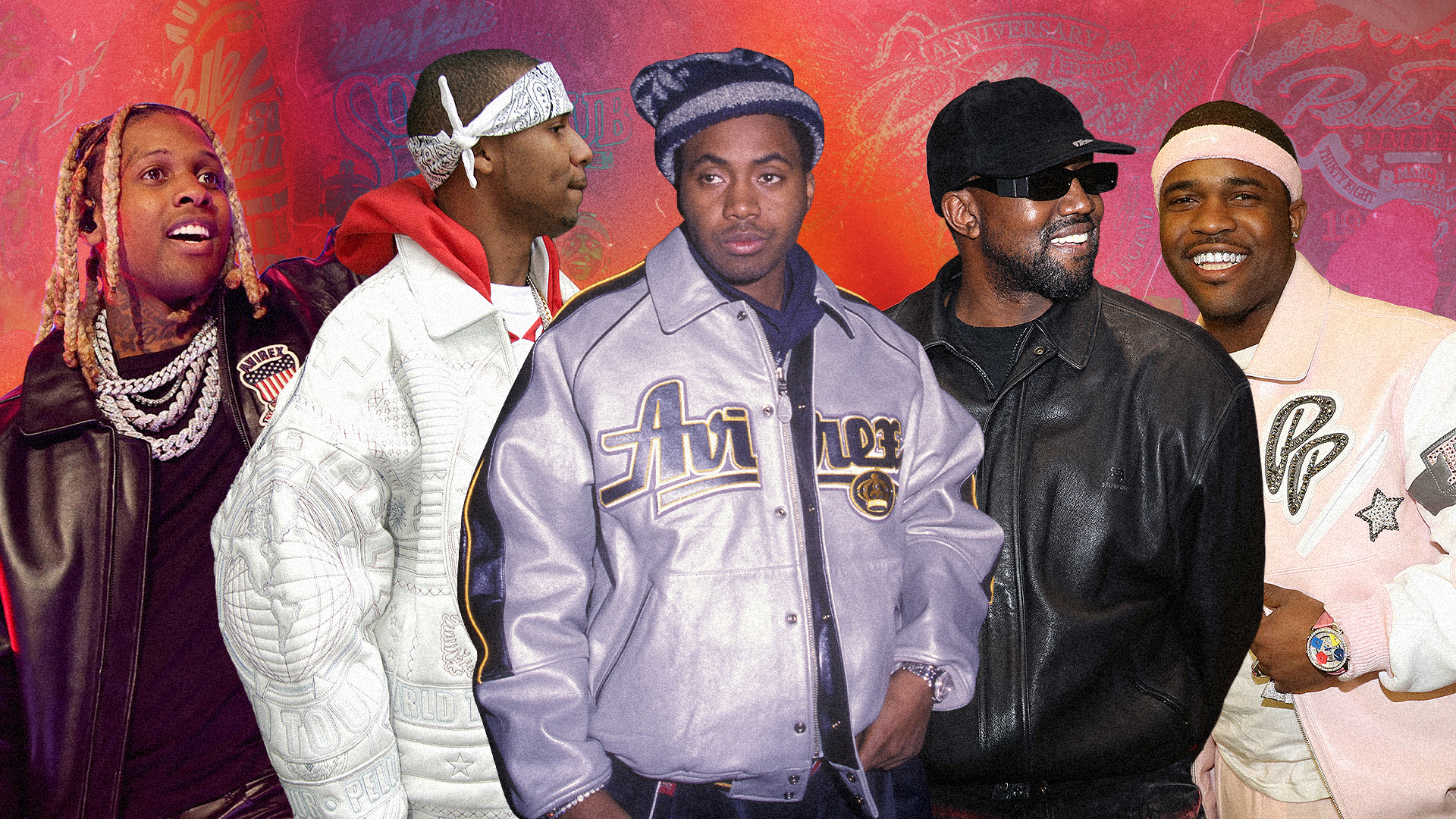
Leather jackets have always been synonymous with cities like New York and hip-hop culture at large. And brands including Pelle Pelle and Avirex, which were both founded in the 1970s, created leather garments that resonated with the culture and became street status symbols hip-hop artists embraced throughout the ‘90s and early 2000s. But you can still feel their influence today. Supreme consistently releases embellished leather jackets that pay homage to the styles set by Pelle Pelle. While the British skateboard label Palace has referenced UK Garage and American hip-hop culture by dropping officially licensed Avirex jackets several times since 2017. The oversized leather Balenciaga “Blouson” that Kanye West wore this winter closely resembles the military style popularized by Avirex—Ye also rapped about wearing Pelle Pelles on the Donda track “Pure Souls” and wore a bright blue Pelle Pelle in the new Netflix documentary jeen-yuhs before he got on. And even though Drake rocked a new Prada leather bomber designed by Miuccia Prada and Raf Simons, it’s not surprising that an Instagram page like @PellePelleLeather said it was inspired by Buchanan’s designs. And thanks to an Avirex relaunch, rappers like Lil Durk, Meek Mill, Lil Baby, and even Roddy Ricch are wearing new versions of their jackets.
“When we both had Pelles on
And we was scammin’ for the prom before Chief Keef was ‘Bang, Bang’”—Kanye West on “New Souls”
While the leather jacket industry is niche, brands like Avirex and Pelle Pelle developed a cult following in cities by fostering a symbiotic relationship with street culture that goes back decades. But as with most trends within hip-hop, it all started with hustlers.
“When I was a kid, all the older guys getting money had on a [leather] 8-Ball or the shearling. That was a sign of success back then,” remembers stylist Boz Bradshaw, a Flatbush, Brooklyn native who worked closely with hip-hop stylist Monica Morrow to dress rappers like Cam’ron and Jay-Z in leather jackets throughout the late ‘90s and early 2000s. Bradshaw is old enough to remember when an 8-Ball leather jacket was a beautiful, but risky, item to wear. “Back then in the Lower East Side on Delancey and Orchard, all those streets had the 8-Balls and Mauri sneakers. Downtown Brooklyn at Albee Square Mall, Jamaica Avenue [in Queens], Harlem. All those leather jacket retailers on Delancey Street had stores out there too. And you could have gotten robbed for a leather jacket in any of those areas.”
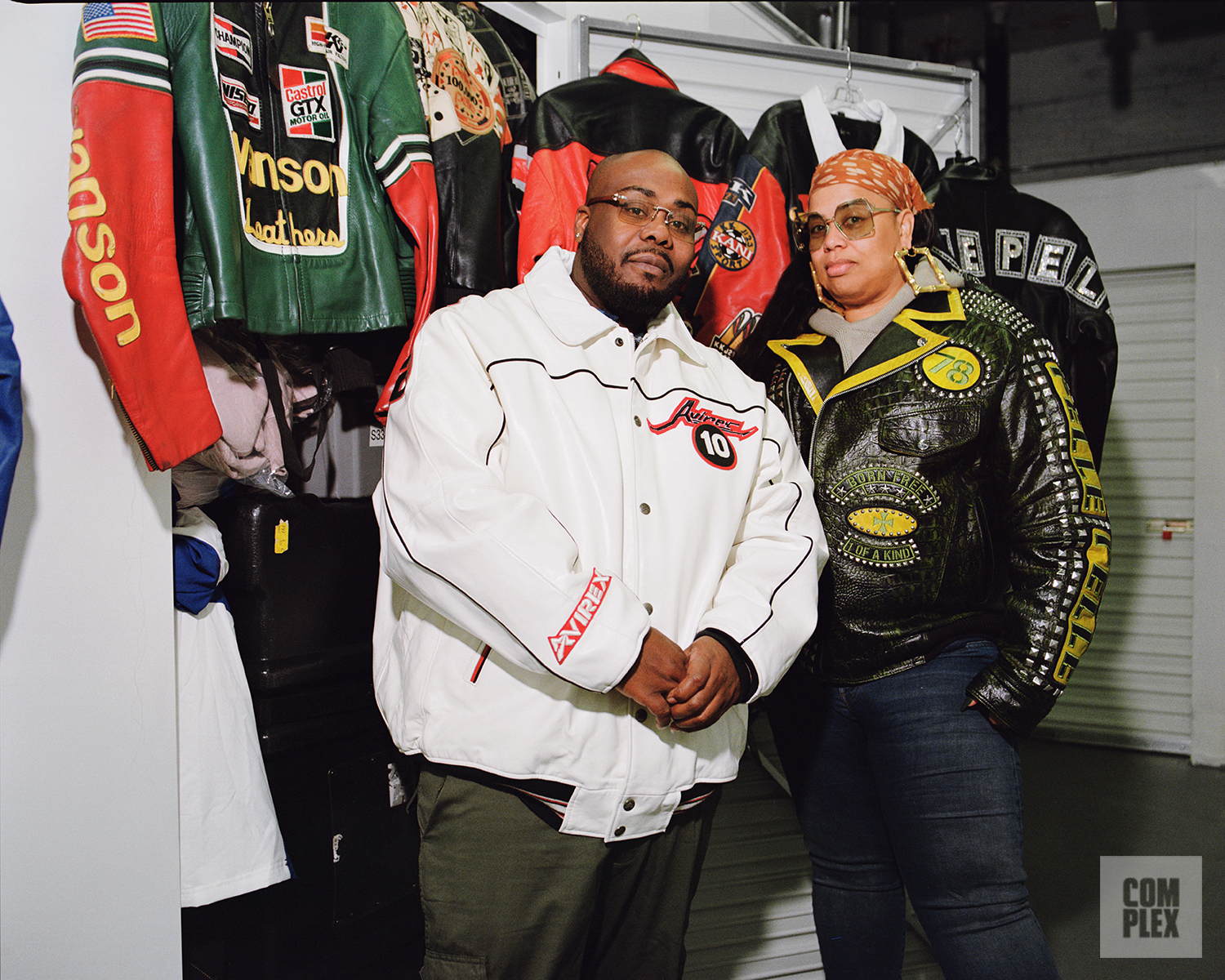
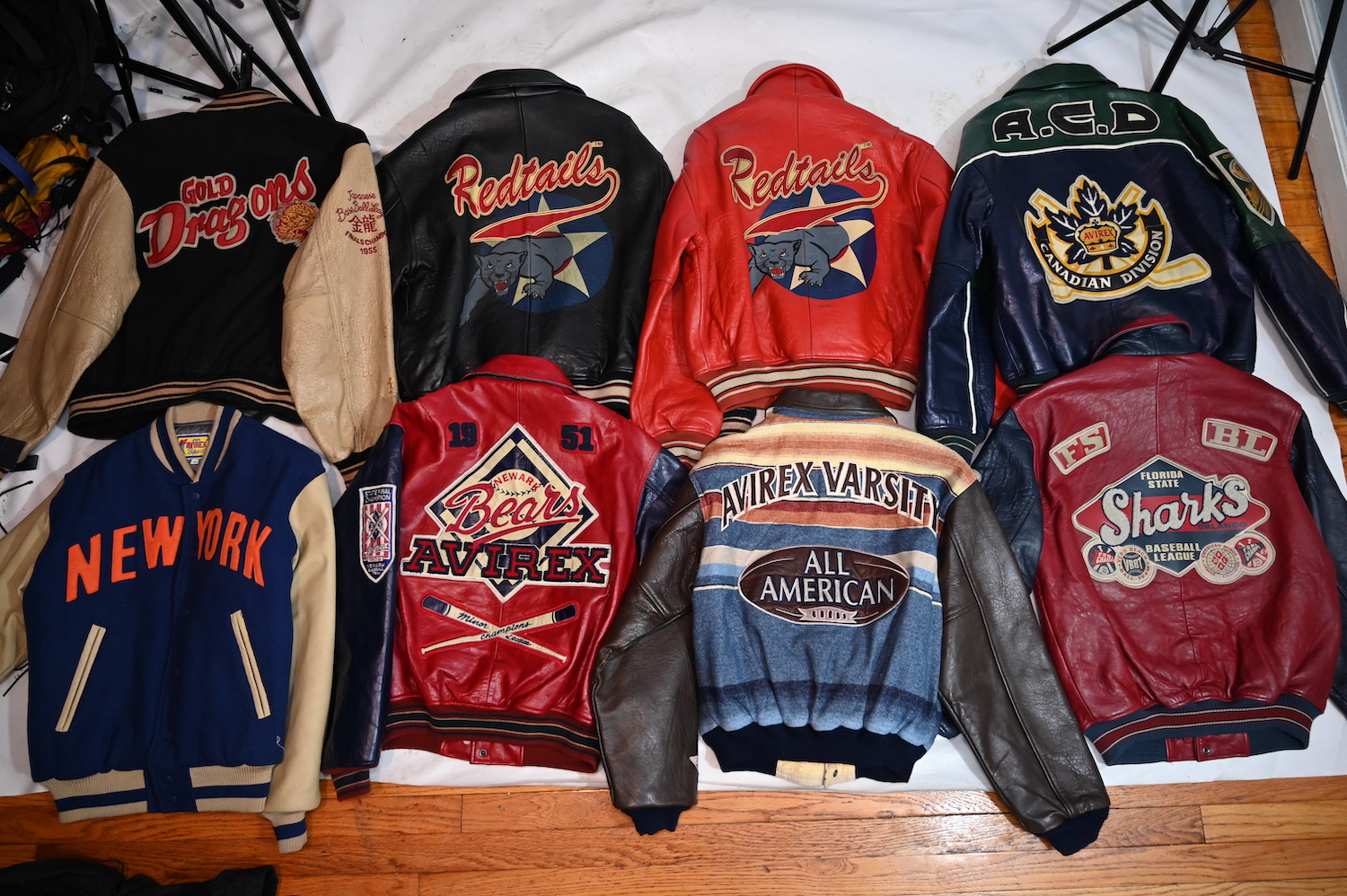
But the Casiano brothers were more drawn to the brand’s colorful leather varsity jackets that were distributed in streetwear boutiques like Jimmy Jazz or Dr. Jays in Uptown Manhattan. “That’s when Avirex took it to another level, by making up their own teams within football, hockey, and baseball,” remembers John Casiano, who runs the @professor.avirex Instagram page with his brother Vic—they resell vintage Avirex jackets from the ‘80s or ‘90s for as much as $1,500. “I think Avirex caught wind of the rappers wearing it because they were the first ones promoting the varsitys.”
“Back then an Avirex, if you had one, was a real fly look.”—Havoc of Mobb Deep
According to Clyman, Avirex began producing these varsity jackets to expand the label’s commercial offerings while also staying true to their holistic vision of re-creating iconic American military apparel. So Avirex began replicating stadium jackets worn by youth in the late 1930s who were a part of President Roosevelt’s Civilian Pilot Training program. Then someone in Avirex’s sales team saw an opportunity.
“One of our sales reps asked if we could give a varsity jacket to Fat Joe to wear in 1993. We said yes and the rest is history,” said Clyman. “The hip-hop community intuitively understood the value and craftsmanship of the jackets we made and they were works of art never duplicated since then.”
Along with their iconic bombers, Avirex’s varsity jackets became emblematic of ‘90s hip-hop culture. Fat Joe wore his Avirex varsity in the 1995 Hype Williams-directed music video for LL Cool J’s famous remix of “I Shot Ya.” Biggie Smalls posed for Ernie Paniccioli’s camera lens while wearing a red Avirex. And for Junior M.A.F.I.A’s “Get Money” video, he wore the label’s varsity jacket while caressing Charli Baltimore. Aside from Nas, it could be argued that no rappers wore Avirex better than Mobb Deep, who perfectly captured the brand’s military aesthetic in their music video for “Hell on Earth,” which fittingly ends with Prodigy and Havoc’s crew walking through razed city streets in Avirex leathers.
“I actually got my first Avirex after high school, when I was able to afford one. I remember we had a photo shoot and I bought a red one just for the shoot, I couldn’t wait to wear it. Back then an Avirex, if you had one, was a real fly look,” remembers Havoc of Mobb Deep. “They were so popular in QB (Queensbridge) because before that we were just wearing army jackets that didn’t cost much. So having one meant you had some bread.”
“The East Coast itself was a $10 million territory in the Bronx, Brooklyn, and Queens.”—Joseph D’Anna, Avirex’s VP of Sales and Marketing in the ‘90s.
Because New York was Avirex’s hometown runway, the brand soared within the five boroughs. The New York-based brand’s flagship store was just blocks away from Hot 97’s radio station in SoHo and there was even a factory store in Long Island City—a short walk from the Queensbridge Houses. But generally, the ‘90s was a golden era for clothing brands that embraced hip-hop culture. Alongside companies like Karl Kani, Fubu, and Tommy Hilfiger, leather jacket labels also foresaw the influence of hip-hop culture long before it became a common marketing ploy. Both Avirex and Pelle Pelle seeded their garments to rappers, designed custom pieces for them free of charge, and featured them in ad campaigns that filled the pages of Vibe, XXL and The Source. Avirex highlighted rising hip-hop groups like Brand Nubian in print ads while Pelle Pelle spotlighted a young Cam’ron.
“While it took a long time for the luxury brands to respect us, those brands were specifically making shit for the culture, so they got it. We were their market and they embraced it,” remembers Morrow, who’s worked directly with leather jacket brands to make custom pieces for her previous clients that included Ghostface Killah and The Diplomats. “You had folks at Pelle Pelle like John Green who understood the culture. It wasn’t like going to Fendi and begging them to give you something while security follows you around the store. These guys were like: ‘This is your shit.’ It was love.”
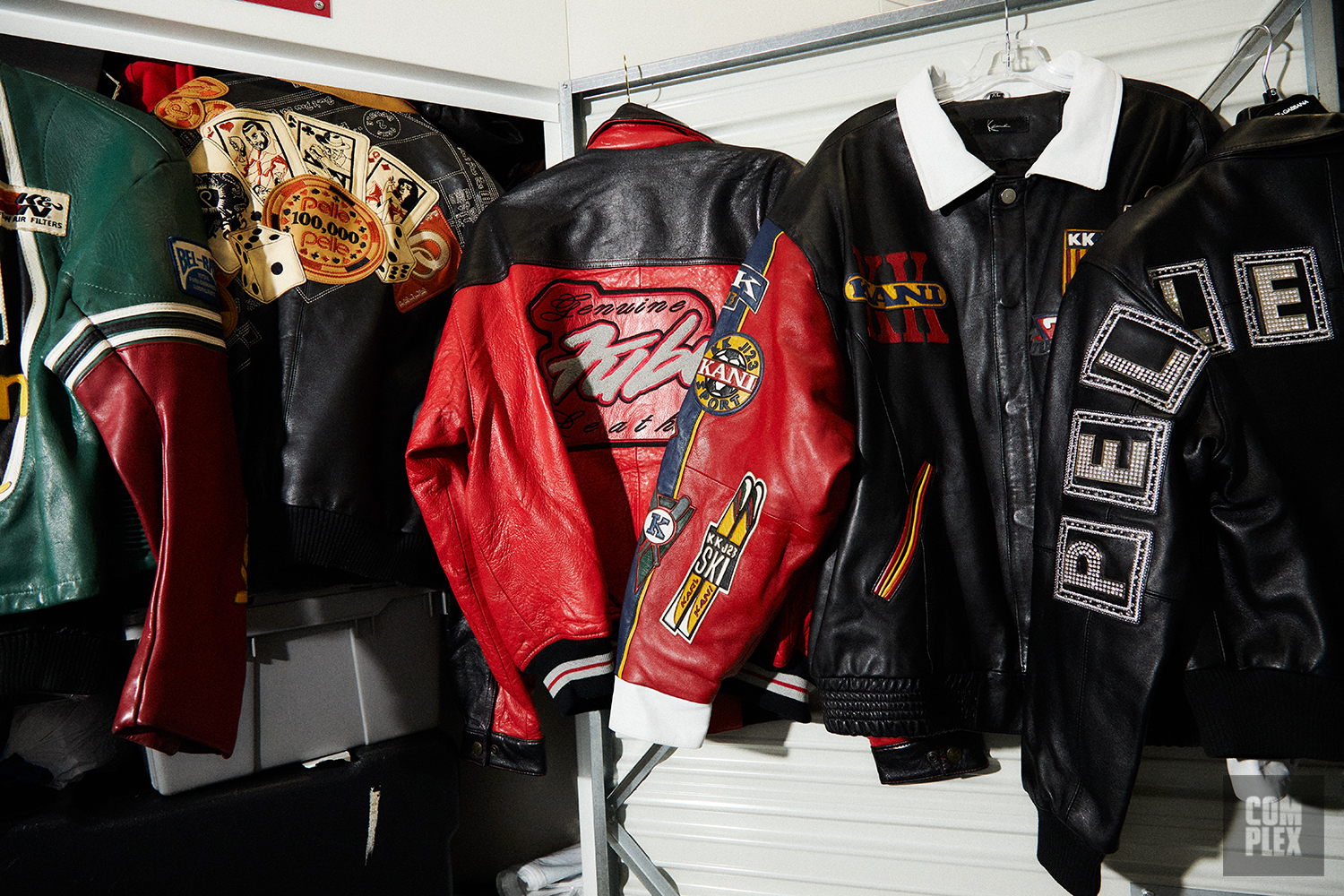
While Buchanan admits he’s shy and not one to rub shoulders with A-List rappers like prolific leather jacket designer Jeff Hamilton, Pelle Pelle remained popular long after the streetwear boom of the ‘90s because it constantly paid attention to how hip-hop fashion was changing. Odds are, if you watch a rap video from the early 2000s, anything from “Dipset Anthem” to Twista’s “Overnight Celebrity,” you’ll likely see someone wearing an oversized Pelle Pelle. But the brand’s relevance in the market at the time wasn’t just luck. It was because of employees like John Green, a marketing director for Pelle Pelle since 2002, who constantly found fresh rappers to represent the brand throughout the 2000s and early 2010s. Green was the one who got Fat Joe to wear an iconic gray “Soda Club” Pelle Pelle for the “Lean Back” music video and was behind those custom ones worn by ASAP Rocky and Ferg in recent years. But the East Tremont, Bronx native also worked closely with boutiques nationwide to make sure Pelle jackets were presented well in stores and get direct feedback from the streets, which he would share with Buchanan.
“Who better on your front line to tell you if you’re doing something good? A lot of times the feedback that we were getting from those stores was right on because they’re actually dealing one on one with the consumer,” says Green, who points out that Pelle Pelle jackets were intentionally designed to match with trendy sneakers or popular accessories such as B.B. Simon belts. “They’re coming into the stores, pulling the jackets off the walls and asking why they don’t do it in this color or that color. As opposed to us sitting in the design studio and trying to figure out what the consumer wants.”
Together these brands helped create a multimillion dollar market that was driving sales to independently owned boutiques and bringing ad dollars to culture magazines—Avirex spent $3 million alone in 1998 to run print ads in publications like Details, Spin, Vibe and Blaze.
“Jimmy Jazz and stores like that in the city became tremendous accounts,” recalls Joseph D’Anna, Avirex’s VP of Sales and Marketing in the ‘90s. “The East Coast itself was a $10 million territory in the Bronx, Brooklyn, and Queens.”
Pelle Pelle brought in millions in sales over the years, hitting a whopping volume of $60 million back in 2002. Both Avirex and Pelle Pelle would even present runway collections during New York Fashion Week in the 2000s. Although outerwear has long been a staple within hip-hop culture, the success of brands like Pelle Pelle and Avirex showed it was an extremely profitable category for fashion brands like Rocawear and Sean John to hone in on.
“A brand like Avirex was a true outerwear company. But then you had brands like Fubu where their company wasn’t an outerwear company but it played a significant role,” says Elena Romero, a journalist who covered the early streetwear industry for trade publications like WWD and DNR from the mid-1990s and into the early 2000s. “I didn’t necessarily see one brand influencing another. They were competing against the same space in the same market and all recognized that outerwear was a major category for their customer.”
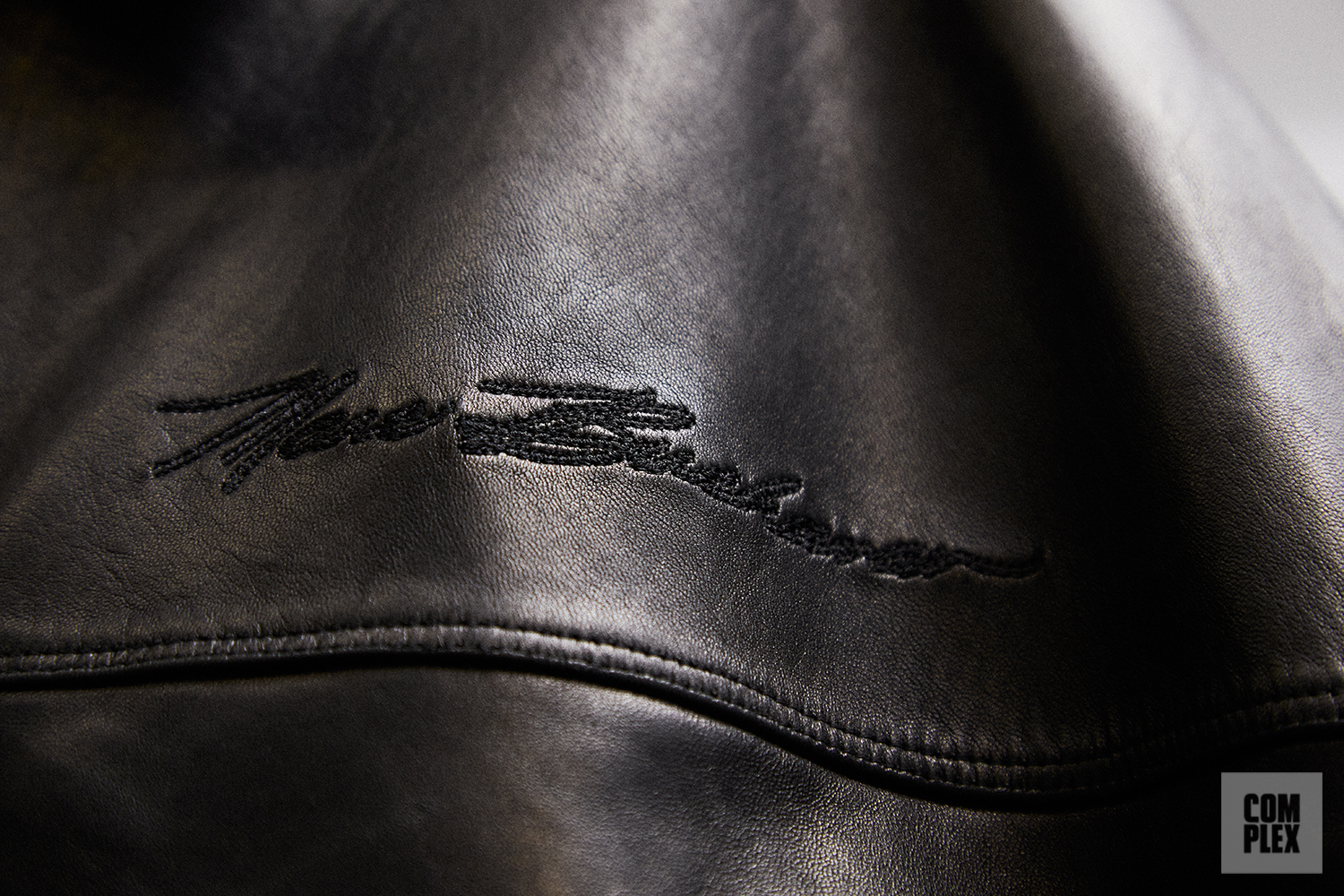
But despite their success, these leather jacket labels eventually began losing their skin. In 2006, Clyman sold Avirex to the entrepreneur Marc Ecko for an undisclosed sum. Despite Avirex being in a profitable licensing agreement with Ecko since 2004 to produce an Avirex men’s sportswear line, which was estimated to pull in as much as $80 million back in 2006, Clyman told Complex he felt Avirex “lost its soul” and was “fractured” as a label. Additionally, Avirex had previously licensed the brand to owners in Japan and Europe back in 1996 who had completely different visions for his brand “Europe was concentrating on one look, Japan on another and the USA on another,” wrote Clyman. After selling Avirex, Clyman went off to launch Cockpit USA, a leather jacket label that continues to reproduce historic American aviation apparel today.
And even though Pelle Pelle was still popular amongst rappers ranging from Dave East to Chief Keef throughout the 2010s, the brand’s sales went down from $60 million in 2002 to $40 million in 2008. By 2018, Pelle Pelle had quietly exited the market with little to no explanation. But now, Buchanan has finally revealed that the brand’s sudden disappearance was due to the challenges he faced when many of the small specialty stores he worked with began closing.
“You could see it happening in the early 2010s. Different urban stores started disappearing and going bankrupt,” says Buchanan, who refused to sell through department stores even when Pelle Pelle was struggling. “I remember when department stores got into the urban business and they began opening up urban departments within their stores. I looked at that and I said ‘That’s the end of it.’ When these people get on like a bandwagon, it’s over because they had no interest in it. They didn’t care or respect the customer. They’re just in it for the dollar.”
“I have a lot of people asking me to bring the line back. It’s very tempting and I will eventually do it.”—Marc Buchanan
Romero, who is now an assistant professor at the Fashion Institute of Technology and the author of Free Stylin’: How Hip Hop Changed the Fashion Industry, recalls how the rise of curated streetwear boutiques within department stores led to the demise of many early streetwear brands. Like Buchanan, she agrees Pelle Pelle was attracted to these boutiques or specialty stores as stockists because they developed a personal relationship with the designers, whereas department stores were focused more on big volume sales. “You could do cash on delivery in a mom and pop specialty store, you can’t do that in a department store,” says Romero. “If your stuff doesn’t sell, it’s gonna be on sale, to the point where they can’t give it away and could oversaturate the market.”
Although commercial leather jacket brands have struggled, the custom leather jacket business has always thrived by helping artists develop their own unique style as they grow within the industry. In the ‘90s, the Harlem-based haberdashery 5001 Flavors made custom leather jackets for Biggie Smalls that were featured on the cover of The Source and pieces worn by Cam’ron and Missy Elliott for their respective debut album covers. Recently, they made leather looks for Fat Joe to wear while he was guest-hosting The Wendy Williams Show alongside Remy Ma. But one of the label’s proudest achievements was making all the leather looks for Total and The Notorious B.I.G.‘s “Can’t You See” music video to promote the 1995 film New Jersey Drive. At the time, the stars in the video and movie were wearing leather looks by 5001 Flavors at different stages in their career. Biggie Smalls was an emerging artist, Heavy D was transitioning into acting, and Puffy was becoming a music business mogul.
“I think for hip-hop, leather has always been synonymous with a certain level of style or wealth. It bumps your picture up and makes more of a visual statement,” says 5001 Flavors’ president and CEO Sharene Wood.
Even in the 2000s, rappers would still seek out designers such as Dapper Dan for a custom leather jacket with a giant Gucci logo on the back—similar to the one Eric B. wore on the cover of 1988’s Follow The Leader. Now, post Dapper Dan’s designs hitting Gucci’s runway without any credit, customers can go to his atelier in Harlem and purchase official jackets made with fabrics supplied by the Italian luxury house.
“I sent Boz this picture of Offset [in Balenciaga] and I was telling him how 20 years ago they would have found that look intimidating,” says Morrow. “He got a durag to the side, his pants are on three sizes too big, and a leather jacket that was damn near to his knees. But now this is fashion because it’s Balenciaga, but when we were doing it, it was intimidating and too hood.”
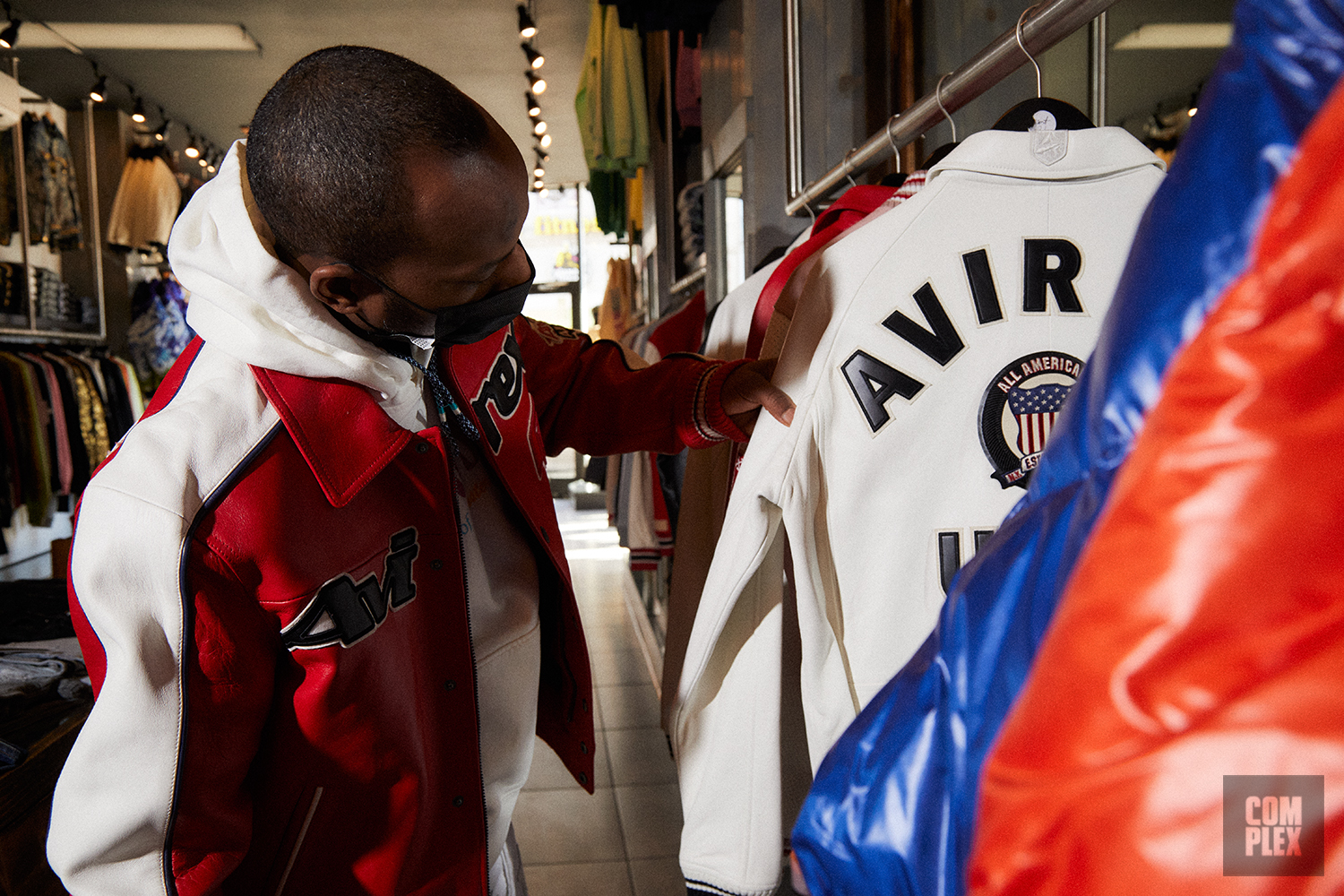
Fueled by nostalgia and the 2000s continuing to trend, many heritage leather jacket brands are reentering the market. After Avirex’s trademark sat unused for years in the United States, the label’s current owners, Centric Brands, relaunched the line this winter with revived designs from the ‘90s and contemporary outerwear inspired by its archive. For their reentry into the market, they brought back old Avirex staffers. Avirex’s current VP of Design, Mia Dell’Osso-Caputo, was a member of their original design team in the ‘90s, and Mindy Gale of Gale Branding, worked closely with hip-hop stylists and architected ad campaigns for the brand during its golden years. She’s leading Avirex’s advertising efforts today, which included a campaign that featured Rudy Gay of the Utah Jazz, the pioneering B-boy Crazy Legs, and more.
Avirex’s current stockists still includes niche specialty fashion stores like O Fresh in the Bronx, whose owner, Oumar “O Fresh” Bah, has been selling leather jacket brands like Pelle Pelle and Avirex since the 2000s. O Fresh says the moment he heard Avirex was coming back, he immediately went after the account and ordered 60 leather jackets despite the fact that they were retailing for $1,298-$1,498—nearly double the price they cost in the early 2000s.
“Before we ordered, one of my workers was like: “Avirex? Why would you order this? Did you see the prices?’ I said ‘Don’t worry, it’s going to move.’ After I posted them on our Instagram, people were calling our store back to back for the next two days,” says O Fresh, who sold Avirex’s latest releases to local New York rappers like Lil Tjay and Young M.A. “A week later, we sold out of everything. I called Avirex back to order more, but they had nothing available.”
Unlike Avirex and Pelle Pelle, which always considered hip-hop in its marketing, heritage leather motorcycle jacket manufacturer Vanson, which was founded by Michael Van der Sleesen in 1974, has recently begun to consider the culture in a way it never has. Popularized in the ‘90s via iconic music videos like 112’s “Only You,” Vanson strictly maintained its position as an American manufacturer of leather motorcycle jackets—they would sponsor motorcycle races—rather than a fashion label with celeb-fronted marketing campaigns, lookbooks, and sportswear lines. Although Vanson works with brands like Comme des Garçons and Supreme, after declining sales due to the Covid-19 pandemic, Vanson hired the Bronx-born designer Davon Bean as creative director last year to help boost the brand’s stature in the market.
“I stay at Van der Sleesen’s house all the time. Every time when I go to the factory, I stay over there and we have conversations until like two in the morning,” says Bean, who has helped Vanson secure new stockists and collaborations with rappers like Dave East. ”He gives me more insight on the motorcycle industry that I may not know, but I give him insight on hip-hop culture and the impact Vanson had on it. He loves it.”

Although Buchanan has been out of the leather game for some time, he stays abreast with what’s happening in the industry. He’s taken notice of Avirex’s relaunch and pieces from brands like Supreme that are inspired by his work. He respects Avirex because of their leather craftsmanship. As far as Supreme, he thinks the production on their leather jackets could be better.
“Supreme, their business is sweatshirts and sportswear. When they’re doing leather jackets, they really don’t know what they’re doing. I see it all the time,” says Buchanan. “The quality of the leather and the stitching is not very good or they haven’t done other parts right. Leather is a whole other category. If you’re thinking that you could put together a wool melton jacket, leather is completely different.”
When asked questions about the potential relaunch of Pelle Pelle, Buchanan is careful to not spill too many details. As of today, Pelle Pelle’s website domain is offline. But in late February, posts appeared on its IG account, which has been inactive for three years. One officially announced that Pelle Pelle will return for the Fall 2022 season. Buchanan says it has taken some time to strategize on a relaunch because he has been focused on recovering from a recent quadruple bypass heart surgery. But he’s come across pictures from Pelle Pelle Day events in New York and Chicago and says it “sends him through the roof” to see a younger generation continue to support his brand.
“I have a lot of people asking me to bring the line back. It’s very tempting and I will eventually do it,” he tells Complex. “The main thing is that the end consumer is asking for Pelle. If I come back into business, it’s going to be for him.”
But Buchanan would be operating in a very different market and facing competition from luxury brands in a way he never has. Artists like Jim Jones, who were hustling down prices for Pelle Pelles on 145th and Broadway in the early 2000s, can now be seen walking the runway in an all-leather look for Off-White’s recent Paris Fashion Week presentation. But it’s clear that Buchanan’s label is still well-remembered by the masses. So much so that, when the late Virgil Abloh produced leather jackets for his final Louis Vuitton collections, many people on social media compared it to Pelle Pelle. While stylists like Morrow and Bradshaw agree that most rappers today would rather buy leather jackets from high-end designer labels like Louis Vuitton rather than a brand like Pelle Pelle or Avirex, they believe that these original leather jacket labels will always hold a unique cachet within hip-hop culture.
“It was a feeling that you felt wearing those leathers. When you rocked a Pelle, it wasn’t for middle or upper-class America to look at you and go ‘Oh, nice,’” says Bradshaw. “It was for everybody else and the people who understood. You found your identity in those jackets. You felt the music and the fashion went hand in hand.”
Lead Image by Mustafa Hussain. Additional ‘Pelle Pelle Day’ photography by @armanilens and Britney Evans (@ratchet_professor.)

